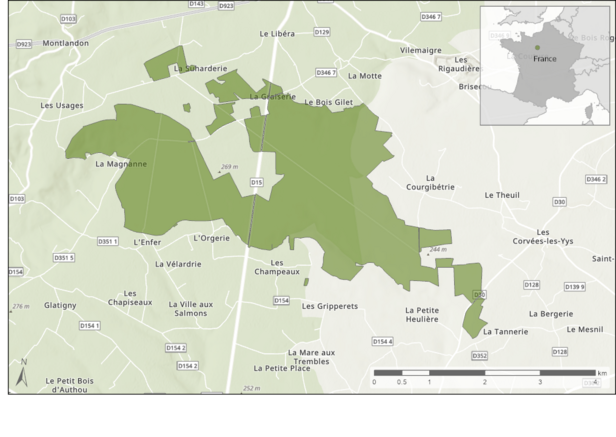
C27 Bois Landry ¶
Management of a multifunctional forest: a collaborative experience ¶

General information on the Bois Landry.
| Total forest area | 1206 ha |
| Main management types | Conversion from coppice with and without standards to irregular forest management / continuous cover forestry |
| Total standing volume | 186 m³/ha – 170 trees/ha |
| Annual growth | 3.97 m³/ha |
| Annual cut | 2 m³/ha |
| Deadwood (standing and lying) | 1.6 m³/ha |
| Altitude | 200–270 m a.s.l. |
| Ownership | Private landowner group Eugène Daubeck |
| Climate | Oceanic with temperate summers, average annual rainfall reaching 590 mm, and average minimum and maximum temperatures of 1 °C and 8 °C in February (coldest month), and 13 °C and 25 °C in August (hottest month). |
| Soil | The soils have generally good potential on the plateau, with a reserve for temporary hydromorphic zones; quite poor on the Perche sand and on slopes. They are of a brown earth type leached throughout the massif with a silty-clay texture and are quite deep on flint clays (1 to 2 m deep) and are shallow to superficial on slopes and outcrops of Perche sands. |
| Geology | The geological layer is made up of Upper Cretaceous formations represented, over most of the territory, by sedimentary flint clays (eastern part) and Perche sands that outcrop on the slopes to the west and north of the massif. |
| Protected areas | Natura 2000 – Forêts et Etangs du Perche – Birds Directive – Type A (ZPS) – Code: FR2512004 – Arrêté du 27/04/2006 – 47 681 ha |
| Special administrative status | Territoire pilote pour la gestion et de la préservation des écosystèmes forestiers et de la biodiversité Label Stratégie Nationale pour la Biodiversité [Pilot territory for the management and conservation of forests and biodiversity – National Strategy for Biodiversity label]. Territoire Wildlife Estate ‘Territoire de Faune Sauvage’ [Wildlife Area] |
